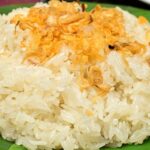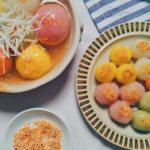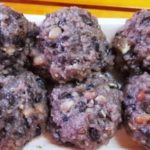In Bac Kan, there exists a small yet mighty cake that boasts a rich array of ingredients and distinct flavors. Lovingly named “Banh Troi,” or “Peng Pha,” this treat is a true delicacy.
Comparable in size to a longan fruit, Banh Troi features a white exterior with subtle brown hues peeking through from its filling. Beneath its unassuming appearance lies a harmonious blend of carefully selected ingredients, each contributing to the unique flavors that characterize the cuisine of Bac Kan. This cake is not just a culinary symbol but also a testament to the love, dedication, and craftsmanship of the locals.
Banh Troi is a staple during festivals, Tet holidays, and especially in New Year ceremonies. It is believed to bring good fortune and positivity for the year ahead, making it a cherished and sacred treat, symbolic of life’s blessings.
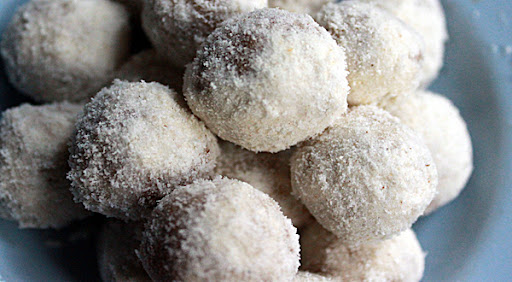
Banh Troi is a staple during festivals, Tet holidays, and is especially used in New Year ceremonies
The primary ingredients in this cake include glutinous rice, white liquor, dark tea, and cane sugar. The process begins with finely ground rice flour, which is then mixed with a strong dark tea infusion to impart a brown hue and a subtle astringent taste. A touch of white liquor is added for aroma, and the mixture is skillfully kneaded until it reaches the perfect consistency.
Once ready, the dough is skillfully shaped into small balls, roughly the size of a longan fruit. This step requires dexterity to ensure uniform and aesthetically pleasing cakes. The shaped dough is then carefully dropped into a boiling cauldron of oil, frying to a golden perfection. Once the desired color is achieved, the cakes are removed and drained.
Meanwhile, cane sugar is melted and boiled to a thick syrup. The freshly fried cakes are then soaked in this sugary delight, absorbing the sweet nectar, before being immediately rolled in a coating of powdered sugar.
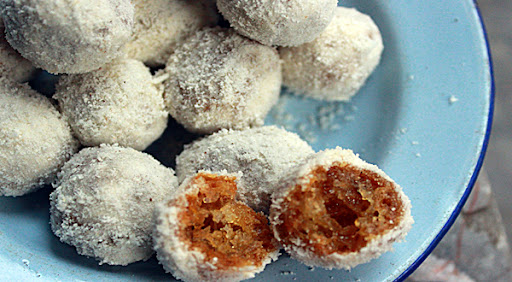
The primary ingredients for Banh Troi include glutinous rice, white liquor, dark tea, and cane sugar
Ms. Diem, a renowned Banh Troi artisan, emphasizes the critical step of immersing the cakes in the molten cane sugar. Maintaining a temperature of approximately 70 degrees Celsius is essential to allow the cakes to absorb the perfect amount of syrup, creating a delectable fusion of flavors.
When savored, Banh Troi offers a complex sensory experience. The initial bite delivers a pungent warmth from the liquor, followed by the sweetness of the sugar, and a subtle astringency from the dark tea, all rounded off with the rich, buttery notes of the glutinous rice. This harmonious blend captivates the palate, leaving a lasting impression.
“Banh Troi transcends beyond a mere delicacy of Bac Kan; it embodies the profound respect and reverence for our ancestors,” shares Ms. Diem. “We offer the finest delicacies to heaven and earth, praying for a peaceful and prosperous new year. This cake’s inclusion in the list of Vietnam’s 100 most renowned dishes is a testament to its cultural significance.”
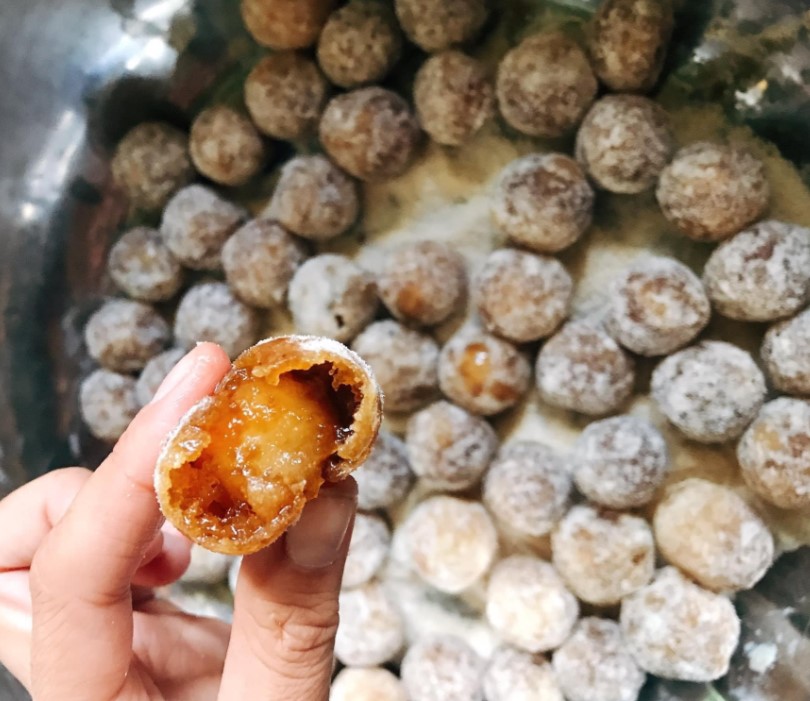
Once a local delicacy, Banh Troi has now gained widespread popularity and is sold across many provinces and cities in Vietnam
Once a closely guarded treasure of Bac Kan, Banh Troi has now ventured beyond its regional boundaries, capturing the hearts of many across Vietnam. Tourists visiting Bac Kan often seek out this delicacy as a memorable souvenir for their loved ones.
According to online markets and e-commerce platforms, Banh Troi is carefully packaged and sold for approximately 50,000 VND per pack of 20 cakes. With its intriguing name and enticing description, it has piqued the interest of city dwellers, prompting them to place orders to indulge in this unique treat.
“When I first started selling Banh Troi, the residents in my apartment building were curious and placed orders to try it,” shares Ms. Hanh, a specialty food seller in Ha Dong, Hanoi. “They were impressed by its distinctive flavor and became regular customers. Apart from personal consumption, many also buy Banh Troi for ancestral worship on the 1st and 15th of the lunar month and during Tet holidays.”
Does Eating Sticky Rice Cause Acne? Understanding the Impact of Sticky Rice on Skin Health
Introducing a culinary delight that is beloved by many – Xôi, a dish that is synonymous with comfort and tradition. But is there a hidden downside to this tasty treat? Could indulging in a bowl of Xôi lead to unwanted skin breakouts? It’s time to uncover the truth and explore whether this humble dish could be the culprit behind those pesky pimples. Join us as we delve into the world of Xôi and uncover the secrets behind its potential impact on your skin.
The Ultimate Guide to Making Delicious Purple Glutinous Rice Wine: A Traditional Vietnamese Delicacy
Introducing the ultimate delicacy, a treat for all ages – the delectable Purple Sticky Rice Wine. This indulgent dish is not just a feast for the senses but also a treasure trove of nutrients. Creating this delicacy is an art, and mastering it is no easy feat. The key to success lies in the perfect harmony of rice, yeast, and the precise fermentation process, ensuring a sensory experience like no other.
The Ultimate Guide to Cooking Delicious and Tender Potato Wedges, Just Like a True Local From Nghe An Province
Potato wedges, or ‘Khoai xeo Nghe An’, is a humble yet beloved dish among the people of Nghe An province, Vietnam. This comforting dish evokes a sense of nostalgia and is an integral part of the local cuisine. Today, we will guide you through the simple process of creating this tasty treat in the comfort of your own home.

























